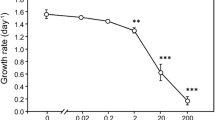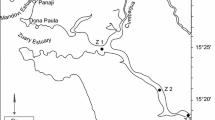Abstract
In situ 24-h incubation experiments were performed to analyse the grazing effects of Daphnia magna on a planktonic microbial community. Three field grazing experiments under different nutrient concentrations were carried out on treated effluents of a wastewater treatment plant. The grazing effects of three different D. magna size classes (small (0.6–1.6 mm), medium (1.7–2.5 mm) and large individuals (2.6–3.7 mm)) were compared. The different sizes classes had similar effects on the plankton community. However, our results showed big differences in effects among experiments. Our findings suggest that in spite of D. magna’s non-selective feeding behaviour and the fact that different developmental stages (i.e. its size) had similar effects on the microbial planktonic community, these effects can differ according to the initial structure and composition of the community and the resulting cascading trophic interactions. Moreover, D. magna effects can be direct through grazing (as is the case with ciliates), or indirect through trophic cascade interactions (as is the case with bacteria).


Similar content being viewed by others
References
Agasild, H. & T. Nõges, 2005. Cladoceran and rotifer grazing on bacteria and phytoplankton in two shallow eutrophic lakes: in situ measurement with fluorescent microspheres. Journal of Plankton Research 27(11): 1155–1174.
Auer, B., U. Elzer & H. Arndt, 2004. Comparison of pelagic food webs in lakes along a trophic gradient and with seasonal aspects: influence of resource and predation. Journal of Plankton Research 26(6): 697–709.
Balayla, D. J. & B. Moss, 2004. Relative importance of grazing on algae by plant associated and open-water microcrustacea (Cladocera). Archiv Fur Hydrobiologie 161(2): 199–224.
Boersma, M., 1995. The allocation of resources to reproduction in Daphnia galeata: against odds? Ecology 76: 1251–1261.
Brooks, J. L. & S. I. Dodson, 1965. Predation, body size, and composition of plankton. Science 150: 28–35.
Brucet, S., J. Compte, D. Boix, R. López-Flores & X. D. Quintana, 2008. Feeding of nauplii, copepodites and adults of Calanipeda aquaedulcis (Calanoida) in Mediterranean salt marshes. Marine Ecology Progress Series 355: 183–191.
Carotenuto, Y. & W. Lampert, 2004. Ingestion and incorporation of freshwater diatoms by Daphnia pulicaria: do morphology and oxylipin production matter? Journal of Plankton Research 26: 563–569.
Carpenter, S. R. & J. F. Kitchell, 1996. The trophic cascade in lakes. Cambridge University, London.
Chisholm, S. W., 1992. Phytoplankton Size. In Falkowski, P. G. & A. D. Woodhead (eds), Primary productivity and biochemical cycles in the sea. Plenum Publishers, New York.
Christaki, U., S. Jacquet, J. R. Doland, D. Vaulot & F. Rassoulzadegan, 1999. Growth and grazing on Prochlorococcus and Synechococus by two marine ciliates. Limnolology and Oceanography 44: 52–61.
DeMott, W. R., 1986. The role of taste in food selection by freshwater zooplankton. Oecologia 69: 334–340.
DeMott, W. R., 1988. Discrimination between algae and detritus by freshwater and marine zooplankton. Bulletin of Marine Science 43: 486–499.
DeMott, W. R., R. D. Gulati & E. Van Donk, 2001. Daphnia food limitation in three hypereutrophic Dutch lakes: evidence for exclusion of large-bodied species by interfering filaments of cyanobacteria. Limnolology and Oceanography 46: 2054–2060.
Dolédec, S. & D. Chessel, 1989. Seasonal successions and spatial variables in fresh-water environments 2. Distinction between seasonal and environmental-effects within floral and faunistical data. Acta Oecologica Oecologia Generalis 10: 207–232.
Dray, S., P. Legendre & G. Blanchet, 2007. Packfor: forward selection with permutation. Canoco, Vancouver: 46.
Fiałkowska, E. & A. Pajdak-Stós, 2008. The role of Lecane rotifers in activated sludge bulking control. Water Research 42: 2483–2490.
Freyer, G., 1991. Functional morphology and the adaptive radiation of the Daphniidae (Bracnchiopoda, Anomopoda). Philosophical Transactions of the Royal Society of London Series B 331: 1–99.
Frost, B. W., 1972. Effects of size and concentration of food particles on the feeding behaviour of the marine planktonic copepod Calanus pacificus. Limnolology and Oceanography 17: 805–815.
Gasol, J. M. & P. A. Del Giorgio, 2000. Using flow cytometry for counting natural planktonic bacteria and understanding the structure of planktonic bacterial communities. Scientia Marina 64: 197–224.
Geller, W. & H. Müller, 1981. The filtration apparatus of Cladocera: filter mesh sizes-and their implications on food selectivity. Oecologia 49: 316–321.
Gilbert, J. J., 1989. The effect of Daphnia interference on a natural rotifer and ciliate community: short-term bottle experiments. Limnolology and Oceanography 34: 606–617.
Gilbert, J. J. & R. S. Stemberger, 1985. Control of Keratella populations by interference competition from Daphnia. Limnolology and Oceanography 30: 180–188.
Groot, M., 1998. Effluent en de hevel-vispassage, een helofytenfilter bijde rioolwaterzuivering De Cocksdorp op Texel? Uitwatererende Sluizen, Edam, MEP-TNO, Den Helder.
Hall, J. A., D. P. Barrett & M. R. James, 1993. The importance of phytoflagellate, heterotrophic flagellate and ciliate grazing on bacteria and picophytoplankton sized prey in a coastal marine environment. Journal of Plankton Research 17: 423–430.
Hillebrand, H., C. D. Dürselen, D. Kirschtel, U. Pollingher & U. Zohary, 1999. Biovolume calculation for pelagic and benthic microalgae. Journal of Phycolgy 35: 403–424.
Jürgens, K., 1994. Impact of Daphnia on planktonic microbial food webs. A review. Marine Microbial Food Webs 8: 295–324.
Lampert, W., 1987. Feeding and nutrition in Daphnia. Memorie dell’Istituto Italiano di Idrobiologia 45: 143–192.
Lee, S. & J. A. Fuhrman, 1987. Relationship between biovolume and biomass of naturally derived marine bacteria plankton. Applied and Environmental Microbiology 53: 1298–1303.
Liu, H., M. Dagg & S. Strom, 2005. Grazing by the calanoid copepod Neocalanus cristatus on the microbial food web in the coastal Gulf of Alaska. Journal of Plankton Research 27: 647–662.
López-Flores, R., D. Boix, A. Badosa, S. Brucet & X. D. Quintana, 2006. Pigment composition and size distribution of phytoplankton in a confined Mediterranean salt marsh ecosystem. Marine Biology 149: 1313–1324.
Matveev, V., M. Lilian & G. J. Jones, 2000. Relative impacts of Daphnia grazing and direct stimulation by fish on phytoplankton abundance in mesocosm communities. Freshwater Biology 44: 375–385.
McMahon, J. W. & H. F. Rigler, 1965. Feeding rate of Daphnia magna Straus in different foods labeled with radioactive phosphorus. Limnolology and Oceanography 10: 105–113.
Menden-Deuer, S. & E. J. Lessard, 2000. Carbon to volume relationships for dinoflagellates, diatoms, and other protist plankton. Limnolology and Oceanography 45: 569–579.
Muylaert, K., L. Zhao, K. Van der Gucht, S. Cousin, S. Declerck & W. Vyverman, 2006. Trophic coupling in the microbial food web of a eutrophic shallow lake (Lake Visvijver, Belgium). Archiv Fur Hydrobiologie 166: 307–324.
Olson, R. J., E. R. Zettler & O. K. Anderson, 1989. Discrimination of eukaryotic phytoplankton cell types from light scatter and autofluorescence properties measured by flow cytometry. Cytometry 10: 636–643.
Pace, M. L., K. G. Porter & Y. S. Feig, 1983. Species- and age-specific differences in bacterial resource utilization by two co-occurring cladocerans. Ecology 64: 1145–1156.
Porter, K. G. & Y. S. Feig, 1980. The use of DAPI for identifying and counting aquatic microflora. Limnolology and Oceanography 25: 943–948.
Porter, K. G., M. L. Pace & J. F. Battey, 1979. Ciliate protozoans as links in freshwater planktonic food chains. Nature 277: 563–565.
Putt, M. & D. K. Stoecker, 1989. An experimentally determined carbon: volume ratio for marine “oligotrichous” ciliates from estuarine and coastal waters. Limnolology and Oceanography 34: 1097–1103.
Quinn, G. P. & M. J. Keough, 2002. Experimental design and data analysis for biologists. Cambridge University Press, Cambridge.
Radke, R. J. & U. Kahl, 2002. Effects of a filter-feeding fish [silver carp, Hypophthalmichthys molitrix (Val.)] on phyto- and zooplankton in a mesotrophic reservoir: results from an enclosure experiment. Freshwater Biology 47: 2337–2344.
Rodríguez, J., F. Jiménez-Gómez, J. M. Blanco & F. L. Figueroa, 2002. Physical gradients and spatial variability of the size structure and composition of phytoplankton in the Gerlache Strait (Antarctica). Deep Sea Research II: Topical Studies in Oceanography 49: 693–706.
Rosenkranz, K., 2001. Some eco engineering aspects of growing Daphnia on treated wastewater, modelling of the kwekelbaars project. Technische Univerität Hamburg, Den Helder.
Ruttner-Kolisko, A., 1977. Suggestion for biomass calculation of plankton rotifers. Archiv für Hydrobiologie Beiheft, Ergebnisse der Limnologie 8: 71–76.
Sanders, R. W., K. G. Porter, S. J. Bennett & A. E. DeBiase, 1989. Seasonal patterns of bacterivory by flagellates, ciliates, rotifers and cladeocerans in freshwater planktonic community. Limnolology and Oceanography 34: 673–687.
Schreijer, M., R. Kampf, J. T. A. Verhoeven & S. Toet. 2000. Nabehandeling van effuent tot bruikbaar oppervlaktewater in een moerassysteem met helofyten en waterplanten, Resultaten van een 4-jarig demonstratieproject op rwzi Everstekoog, Texel. Edam en Utrecht, Hoogheemraadschap Uitwaterende Sluizen en Universiteit Utrecht.
Sommer, U., Z. M. Gliwicz, W. Lampert & A. Ducnacn, 1986. The PEG-model of seasonal succession of planktonic events in fresh waters. Archiv für Hydrobiologie 106: 433–471.
Strathmann, P. R., 1967. Estimating the organic carbon content of phytoplankton from cell volume or plasma volume. Limnolology and Oceanography 12: 411–418.
Telesh, I. V., M. Rahkola & M. Viljanen, 1998. Carbon content of some freshwater rotifers. Hydrobiologia 387(388): 355–360.
Tessier, A. J., E. V. A. Bizina & C. K. Geedey, 2001. Grazer–resource interactions in the plankton: are all daphniids alike? Limnology and Oceanograohy 46: 1585–1595.
Utermöhl, H., 1958. Zur Vervollkommung der quantitativen phytoplankton-methodik. Mitteilungen Internationale Vereinigung Theoretische und Angewandte Limnologie 9: 1–38.
Vanderploeg, H. A. & D. Scavia, 1979. Calculation and use of selectivity coefficients of feeding: zooplankton grazing. Ecological Modelling 7: 135–149.
Vanderploeg, H. A., D. Scavia & J. R. Liebig, 1984. Feeding rate of Diaptomus sicilis and its relation to selectivity and effective food concentration in algal mixture in Lake Michigan. Journal of Plankton Research 6: 919–941.
Vanni, M. J. & W. Lampert, 1992. Food quality effects on life history traits and fitness in the generalist herbivore Daphnia. Oecologia 92: 48–57.
Verity, P. G., C. Y. Robertson, C. R. Tronzo, M. G. Andrews, J. R. Nelson & M. E. Sieracki, 1992. Relationship between cell volumes and the carbon and nitrogen content of marine photosynthetic nanoplankton. Limnology and Oceanography 37: 1434–1446.
Zöllner, E., B. Santer, M. Boersma, H. G. Hoppe & K. Jürgens, 2003. Cascading predation effects of Daphnia and copepods on microbial food web components. Freshwater Biology 48: 2174–2193.
Acknowledgements
This work was supported by a grant from the Comisión de Investigación Científica y Técnica (CICYT), Programa de Investigación Fundamental (ref. CGL2008-05778/BOS) and by a predoctoral grant from the Universitat de Girona (ref. BR06/03). We would like to thank the Consorci de la Costa Brava for allowing us to perform the experiments in the facilities of the Empuriabrava WWTP and for providing us with useful information and data. We would also like to thank the Servei de Control de Mosquits de la Badia de Roses i el Baix Ter for allowing us to use their laboratory facilities. We are also grateful to the Editor and two anonymous reviewers whose comments helped to improve the original submission. Finally, we thank the Modern Language Service of the Universitat de Girona for of the revision the English text.
Author information
Authors and Affiliations
Corresponding author
Additional information
Handling editor: S. I. Dodson
Rights and permissions
About this article
Cite this article
Compte, J., Brucet, S., Gascón, S. et al. Impact of different developmental stages of Daphnia magna (Straus) on the plankton community under different trophic conditions. Hydrobiologia 635, 45–56 (2009). https://doi.org/10.1007/s10750-009-9860-3
Received:
Revised:
Accepted:
Published:
Issue Date:
DOI: https://doi.org/10.1007/s10750-009-9860-3




